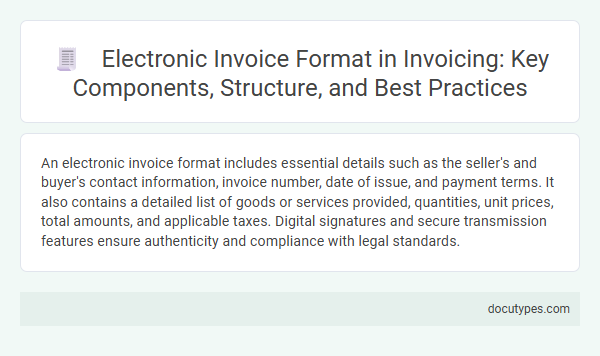An electronic invoice format includes essential details such as the seller's and buyer's contact information, invoice number, date of issue, and payment terms. It also contains a detailed list of goods or services provided, quantities, unit prices, total amounts, and applicable taxes. Digital signatures and secure transmission features ensure authenticity and compliance with legal standards.
Introduction to Electronic Invoice Format
What is included in an electronic invoice format? An electronic invoice format typically contains structured data fields such as invoice number, date, buyer and seller details, item descriptions, quantities, prices, taxes, and total amount. This standardized format ensures accurate, efficient, and secure processing of billing information in digital transactions.
Key Components of an Electronic Invoice
An electronic invoice format contains essential data that ensures accurate and efficient transaction processing. Understanding the key components helps you verify and manage billing information effectively.
- Invoice Header - Includes the invoice number, date of issue, and seller and buyer identification details.
- Line Items - Lists products or services provided, including quantities, unit prices, and total amounts per item.
- Tax and Payment Information - Specifies applicable taxes, payment terms, and the total amount payable.
Standard Electronic Invoice Structure
An electronic invoice format typically includes key components such as sender and receiver details, invoice number, date, and payment terms. Standard electronic invoice structures ensure consistent data representation across different platforms and systems.
This format also incorporates itemized lists of goods or services, quantities, prices, taxes, and total amounts. Structured data fields follow standardized schemas like UBL or XML, facilitating automated processing and validation.
Essential Data Fields in Electronic Invoices
An electronic invoice format contains specific data fields essential for accurate processing and legal compliance. These fields ensure seamless communication between buyers and sellers in digital transactions.
- Invoice Number - A unique identifier assigned to each invoice for tracking and reference.
- Invoice Date - The date when the invoice is issued, important for payment terms and record keeping.
- Seller and Buyer Details - Includes names, addresses, and tax identification numbers of both parties involved.
- Item Descriptions and Quantities - Detailed information about products or services provided, including quantities and unit prices.
- Total Amount and Currency - The complete payable amount, specifying the currency used for the transaction.
- Tax Information - Applicable tax rates, amounts, and classifications required for compliance and reporting.
Including these essential data fields in electronic invoices ensures accuracy, transparency, and regulatory adherence in financial transactions.
Compliance and Legal Requirements
An electronic invoice format includes essential information such as supplier and buyer details, invoice number, date, item descriptions, quantities, and prices. Compliance requires the inclusion of tax identification numbers and digital signatures to meet legal standards and ensure authenticity. Your electronic invoice must adhere to local regulations to maintain validity and support audit processes.
Best Practices for Electronic Invoice Design
An electronic invoice format includes essential details that ensure accuracy and compliance with billing standards. Designing your e-invoice with best practices enhances clarity and facilitates smooth processing.
- Clear Invoice Identification - Every electronic invoice should have a unique invoice number and date for easy tracking and reference.
- Comprehensive Vendor and Client Information - Include full company names, addresses, and tax identification numbers to meet legal and accounting requirements.
- Detailed Line Items - List products or services with descriptions, quantities, unit prices, and totals to provide transparency on charges.
Common Electronic Invoice File Formats (XML, PDF, etc.)
Electronic invoice formats typically include essential data such as invoice number, date, supplier and buyer details, item descriptions, quantities, prices, and tax information. Common electronic invoice file formats are XML, PDF, and EDI, each supporting structured data for automated processing and verification. XML is favored for its flexibility and compatibility with various accounting systems, while PDF ensures easy readability and legal compliance.
Integration with Accounting and ERP Systems
An electronic invoice format typically includes essential data fields such as invoice number, date, supplier details, item descriptions, quantities, prices, and total amounts. These elements ensure accurate transaction recording and facilitate seamless processing.
Integration with accounting and ERP systems allows your electronic invoices to be automatically imported, validated, and reconciled, reducing manual entry errors. This integration streamlines financial workflows and improves real-time data accuracy across business operations.
Security and Data Protection in E-Invoicing
An electronic invoice format typically includes detailed transaction data, supplier and buyer information, and tax details structured in standardized digital formats like XML or UBL. Security features are integrated to ensure data integrity and authenticity throughout the invoicing process.
Data protection in e-invoicing involves encryption methods to safeguard sensitive information from unauthorized access. Digital signatures authenticate the origin and validity of the invoice, preventing tampering or fraud. Compliance with regulations such as GDPR and SOC 2 enhances the security framework of electronic invoicing systems.
What Is Included in an Electronic Invoice Format? Infographic

